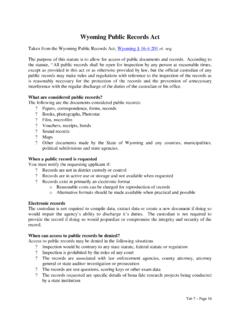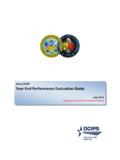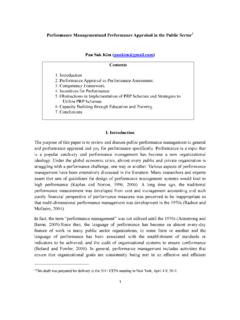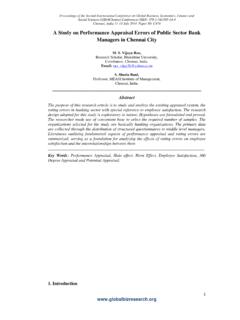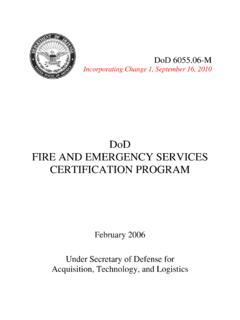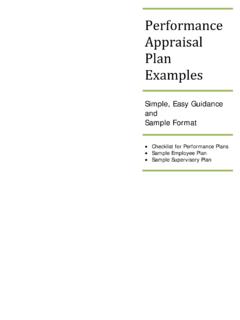Transcription of Position Descriptions and Performance Evaluation
1 Job Qualifications, Position Descriptions & Performance Reviews Introduction Communicating the duties and responsibilities of a Position to the person occupying the Position is an essential element in getting any job done. Setting standards for the Performance of these duties and evaluating the actual Performance are inseparable from developing job duties. This section discusses writing Position Descriptions , the development of objective Performance requirements and the Evaluation of employee Performance . Establishing Qualification Standards In order to get the right person for the job, valid, realistic qualification standards must be set. This is the basic ingredient in securing an employee who can be productive in the shortest period of time with the least cost.
2 Qualifications requirements are the skills, knowledge, abilities and other requirements that are established for each Position based upon the job demands of Position . To be valid, these standards must be job related. Guidelines The following are guidelines for establishing qualification or selection standards. 1. They should be based on a thorough and realistic appraisal of the job requirements. 2. Non-job related items, such as race, religion, sex, etc., must be excluded. 3. Experience, education, knowledge, skill, legal minimum age, valid driver's license and physical condition are the major areas where selection standards can be set with reasonable objectivity.
3 Other areas, such as personality, attitude and judgment are more difficult to assess but should be considered as possible qualification or selection standards if they are important to successful job Performance . 4. Only those qualifications that are clearly needed to perform the job properly should be included. 5. The requirements should be restrictive enough to weed out those applicants that would not be desirable for the job but not so restrictive as to exclude (good) quality candidates. Steps in Establishing Qualification Standards The following are suggested steps in establishing qualification standards. 1. List the items or duties that should be accomplished by the Position .
4 (Workload analysis information should be helpful.). 2. List the knowledge that the applicants must have for consideration. This relates directly to education and experience. 3. List the skills necessary to perform the duties of the Position . Skills are normally associated with developed proficiency or dexterity in some art, craft or trade or the operation of a machine. 4. List the abilities necessary to perform in the job, such as the ability to speak before groups. Tab 5 Page 30. 5. List the conditions for employment, such as residence in the district, successful completion of a medical examination, possession of a valid driver's license, etc.
5 6. Review the above listed items to ensure that all items are job related and are neither less nor more restrictive than necessary. Written qualification standards can be used to develop a job announcement if necessary. Written Position Descriptions Communicating the duties, responsibilities and Performance standards of a Position to the person who occupies the Position can best be done through a written job description. Verbal instructions cannon provide the mutual understanding that is provided by a written description of the duties and Performance requirements. Click here for examples of a district manager Position description and an administrative assistant Position description.
6 Uses of Position Descriptions Written Position Descriptions assist in personnel management in a variety of ways. They assist in: 1. Determining knowledge, skills and abilities necessary to perform the job 2. Establishing equitable and consistent salaries 3. Recruiting 4. Setting Performance standards 5. Increasing communication between supervisors and employees 6. Making staffing decisions 7. Increasing productivity Statement of Adequacy The format of Position Descriptions varies widely among local, state and federal jurisdictions. There is no universal format, but a Position description is adequate if it clearly states the principal duties, responsibilities and supervisory relationships of a Position .
7 This does not preclude the necessity to identify required skills, knowledges, and abilities necessary for establishing qualification standards as discussed earlier in this Procedures Manual. Such qualifications should be established but not included in the Position description. A suggested format for writing Position Descriptions is included in the employee applications section of this Procedures Manual. It is a format that combines both the duties themselves and the standards by which these duties should be performed. Use of this format will save time and effort. Tab 5 Page 31. Keeping Position Descriptions Current Position Descriptions should be kept up-to-date to ensure high productivity and to maintain communications between employees and supervisors.
8 Position Descriptions should be dynamic and reflect changes in duties and responsibilities. A joint review by the employee and the supervisor should be made annually, or more often if necessary, to discuss changes in duties and responsibilities. An appropriate time for this review is in conjunction with the Performance review. Performance Evaluation All employees want to know what is expected of them in their jobs and how well they are performing. A system of Performance Evaluation based on objective criteria should help achieve peak Performance from employees. Evaluating the Performance of subordinates can be very rewarding and enjoyable, but also very trying.
9 It is perhaps the most important job a supervisor has to do. The following benefits may be realized from a formal Performance Evaluation system. 1. Individual Performance will improve. 2. Supervisor-employee relationships will improve. 3. Employee accomplishments and good work will be recognized. 4. Personnel actions, such as pay increases, promotions, removals and rehires, will be based on sound, objective criteria and will be documented. 5. Employees and supervisors will be more aware of job requirements and needed changes in job duties. 6. Employees will be more aware of their supervisor's judgment of their Performance . 7. Training needs will be identified.
10 Performance Standards The standards by which an employee must perform each duty should be communicated to the employee in terms of quantity and quality. Any Evaluation of Performance should in turn be based on these objective, job related criteria. Objectivity is the basic and most essential element in setting these standards. Each duty that is developed for a Position should have a corresponding stand by which it should be performed. This standard should be stated in terms of quantity and quality. For example: Duty: Types correspondence, conservation plans, district newsletters, newspaper copy, various reports and other material necessary for the operation of the office.
